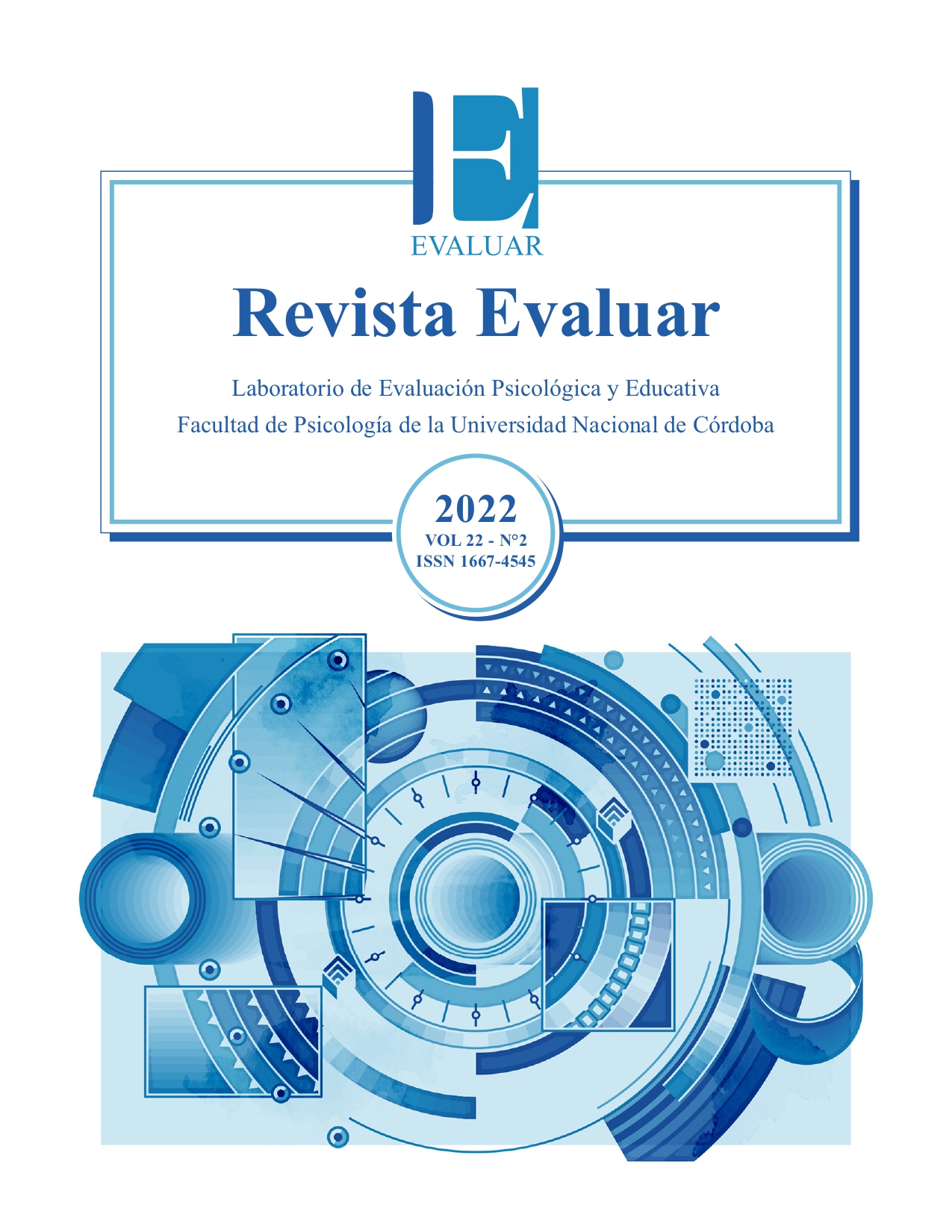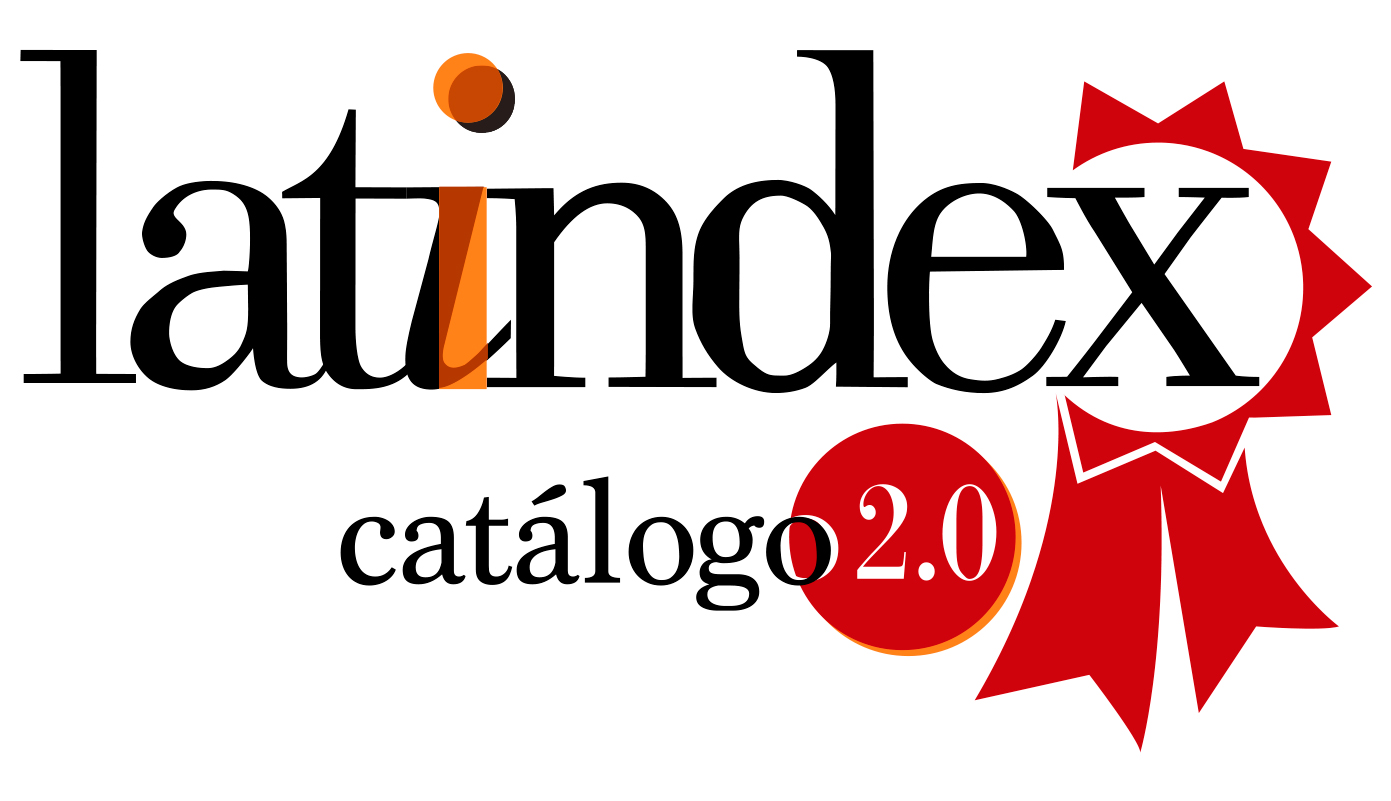Evidence of validity of the Remotely-administered Visual Search Task
DOI:
https://doi.org/10.35670/1667-4545.v22.n2.38686Keywords:
perceptual inhibition, internal validity, reliability, remote administration, conjunction visual searchAbstract
Perceptual inhibition is the executive process that contributes to selective attention by attenuating or reducing the interference effect generated as a result of distracting stimuli present in the environment. Due to the COVID-19 pandemic and other factors, it has been shown that there is a need for tools designed and validated in our environment that enable the assessment in non-face-to-face contexts. For this reason, this study aimed to provide empirical evidence of the internal validity and reliability of a Computerized
Conjunction Visual Search (CVS) task. For this purpose, 97 adults aged between 30 and 35 (M = 32.21; SD = 1.73; 75% females) were assessed under a remote-synchronic administration. The results obtained showed adequate reliability and validity, and that the test respects the postulates of the visual search paradigm on which it is based and that its remote administration form is comfortable for users.
Downloads
References
American Psychological Association. (2017, 1st January). Ethical principles of psychologists and code of conduct. Retrieved from https://www.apa.org/ethics/code
Aydmune, Y., & Introzzi, I. (2018). Inhibición: Una función ejecutiva difícil de medir. Algunas problemáticas en relación con las pruebas de inhibición informatizadas. Psicodebate, 18(2), 7-25. doi: 10.18682/pd.v18i2.741
Aydmune, Y. S., Introzzi, I. M., Olaechea, M. C., & López-Ramón, M. F. (2022). Inhibitory processing training during childhood: A review – Processes-based inhibitory training. In F. Alcantud-Marín, M. López-Ramón, E. Navarro-Pardo, V. Moreno-Campos & Y. Alonso-Esteban (Ed.), Handbook of Research on Neurocognitive Development of Executive Functions and Implications for Intervention (pp. 50-77). doi: 10.4018/978-1-7998-9075-1.ch003
Aydmune, Y., Introzzi, I., & Zamora, E. V. (2020). Tarea de interferencia proactiva (IP) para la medición de la inhibición cognitiva en niños de 6 a 8 años. Revista Evaluar, 20(3), 34-50. doi: 10.35670/1667-4545.v20.n3.31710
Borella, E., Carretti, B., & Pelegrina, S. (2010). The specific role of inhibition in reading comprehension in good and poor comprehenders. Journal of Learning Disabilities, 43(6), 541-552. doi: 10.1177/0022219410371676
Borella, E., & de Ribaupierre, A. (2014). The role of working memory, inhibition, and processing speed in text comprehension in children. Learning and Individual Differences, 34, 86-92. doi: 10.1016/j.lindif.2014.05.001
Brearly, T. W., Shura, R. D., Martindale, S. L., Lazowski, R. A., Luxton, D. D., Shenal, B. V., & Rowland, J. A. (2017). Neuropsychological test administration by videoconference: A systematic review and meta-analysis. Neuropsychology Review, 27(2), 174-186. doi: 10.1007/s11065-017-9349-1
Christ, S. E., Kester, L. E., Bodner, K. E., & Miles, J. H. (2011). Evidence for selective inhibitory impairment in individuals with autism spectrum disorder. Neuropsychology, 25(6), 690-701. doi: 10.1037/a0024256
Christie, J., & Klein, R. (1995). Familiarity and attention: does what we know affect what we notice? Memory & Cognition, 23, 547-550. doi: 10.3758/BF03197256
Cicchetti, D. V., & Sparrow, S. A. (1981). Developing criteria for establishing interrater reliability of specific items: Applications to assessment of adaptive behavior. American Journal of Mental Deficiency, 86(2), 127-137.
Cohen, R. J., & Swerdlik, M. E. (2009). Psychological Testing and Assessment: An Introduction to Tests and Measurement (7th ed.). New York, NY: McGraw-Hill.
Comesaña, A., Richard’s, M. M., & Vido, V. (2019). Comparative analysis of the perceptual inhibition between children and older adults. Psychology & Neuroscience, 12(1), 65-77. doi: 10.1037/pne0000167
Darowski, E. S., Helder, E., Zacks, R. T., Hasher, L., & Hambrick, D. Z. (2008). Age-related differences in cognition: The role of distraction control. Neuropsychology, 22(5), 638-644. doi: 10.1037/0894-4105.22.5.638
Davidson, M. C., Amso, D., Anderson, L. C., & Diamond, A. (2006). Development of cognitive control and executive function from 4 to 13 years: Evidence from manipulations of memory, inhibitions and tasks switching. Neuropsychologia, 44(11), 2037-2078. doi: 10.1016/j.neuropsychologia.2006.02.006
Delalande, L., Moyon, M., Tissier, C., Dorriere, V., Guillois, B., Mevell, K., ... & Borst, G. (2020). Complex and subtle structural changes in prefrontal cortex induced by inhibitory control training from childhood to adolescence. Developmental Science, 23(4), e12898. doi: 10.1111/desc.12898
Diamond, A. (2013). Executive Functions. Annual Review of Psychology, 64(1), 135-168. doi: 10.1146/annurev-psych-113011-143750
Diamond, A. (2016). Why improving and assessing executive functions early in life is critical. In J. A. Griffin, P. McCardle & L. S. Freund (Eds.), Executive function in preschool-age children: Integrating measurement, neurodevelopment, and translational research (pp. 11-43). Washington, DC: American Psychological Association. doi: 10.13140/RG.2.1.2644.6483
Diamond, A., & Ling, D. S. (2020). Review of the evidence on, and fundamental questions about, efforts to improve executive functions, including working memory. In J. M. Novick, M. F. Bunting, M. R. Dougherty & R. W. Engle (Eds.), Cognitive and working memory training: Perspectives from psychology, neuroscience, and human development (pp. 143-431). doi: 10.1093/oso/9780199974467.003.0008
Drasgow, F., & Mattern, K. (2006). New tests and new items: Opportunities and issues. In D. Bartram & R. Hambleton (Eds.), Computer-based testing and the Internet: Issues and advances (pp. 59-75). New Jersey, NJ: John Wiley & Sons. doi: 10.1002/9780470712993.ch3
Duckworth, A. L., Taxer, J. L., Eskreis-Winkler, L., Galla, B. M., & Gross, J. J. (2019). Self-control and academic achievement. Annual Review of Psychology, 70(1), 373-399. doi: 10.1146/annurev-psych-010418-103230
Fleiss, J. L. (1981). Statistical methods for rates and proportions (2nd ed.). New York, NY: John Wiley.
Friedman, N. P., & Miyake, A. (2004). The relations among inhibition and interference control functions: A latent-variable analysis. Journal of Experimental Psychology: General, 133(1), 101-135. doi: 10.1037/0096-3445.133.1.101
Gandolfi, E., Viterbori, P., Traverso, L., & Usai, M. C. (2014). Inhibitory processes in toddlers: A latent-variable approach. Frontiers in Psychology, 5. doi: 10.3389/fpsyg.2014.00381
Hasher, L., Zacks, R. T., & May, C. P. (1999). Inhibitory control, circadian arousal, and age. In D. Gopher & A. Koriat (Eds.), Attention and Performance XVII: Cognitive regulation of performance: Interaction of theory and application (pp. 653-675). Cambridge, MA: MIT Press.
Hazlett, K. E., Figueroa, C. M., & Nielson, K. A. (2015). Executive functioning and risk for Alzheimer’s disease in the cognitively intact: Family history predicts Wisconsin Card Sorting Test performance. Neuropsychology, 29(4), 582-591. doi: 10.1037/neu0000181
Heckathorn, D. D. (1997). Respondent-driven sampling: A new approach to the study of hidden populations. Social Problems, 44(2), 174-199. doi: 10.2307/3096941
Introzzi, I., & Canet-Juric, L. (2019). Tareas de Autorregulación Cognitiva [Software y manual de usuario]. Retrieved from https://tac.com.ar/evaluacion
Introzzi, I. M., Canet-Juric, L., Aydmune, Y., & Stelzer, F. (2016). Perspectivas teóricas y evidencia empírica sobre la inhibición. Revista Colombiana de Psicología, 25(2), 351-368. doi: 10.15446/rcp.v25n2.52011
Introzzi, I. M., Richard’s, M. M., Aydmune,Y., Zamora, E. V., Stelzer, F., García-Coni, A., ..., & Navarro-Pardo, E. (2021). Development of perceptual inhibition in adolescents, a critical period? Symmetry, 13(3), 457. doi: 10.3390/sym13030457
Introzzi, I., Zamora, E., Aydmune, Y., Canet Juric, L., & López, S. (2017). El rol de la inhibición en la Teoría de Integración de las Características. Cuadernos de Neuropsicología, 11(3), 135-150. doi: 10.7714/CNPS/11.3.208
Introzzi, I., Zamora, E., Aydmune, Y., Richard’s, M., Comesaña, A., & Canet-Juric, L. (2020). The change processes in selective attention during adulthood. Inhibition or processing speed? The Spanish Journal of Psychology, 23, e37. doi: 10.1017/SJP.2020.41
Jacob, R., & Parkinson, J. (2015). The potential for schoolbased interventions that target executive function to improve academic achievement: A review. Review of Educational Research, 85(4), 512-552. doi: 10.3102/0034654314561338
Logan, G. D. (1994). On the ability to inhibit thought and action: A users’ guide to the stop signal paradigm. In D. Dagenbach & T. H. Carr (Eds.), Inhibitory processes in attention, memory, and language (pp. 189-239). San Diego, CA: Academic Press.
Mammarella, I. C., Caviola, S., Giofrè, D., & Borella, E. (2017). Separating math from anxiety: The role of inhibitory mechanisms. Applied Neuropsychology: Child, 7(4), 342-353. doi: 10.1080/21622965.2017.134 1836
Marra, D. E., Hoelzle, J. B., Davis, J. J., & Schwartz, E. S. (2020). Initial changes in neuropsychologists clinical practice during the COVID-19 pandemic: A survey study. The Clinical Neuropsychologist, 34(7-8), 1251-1266. doi: 10.1080/13854046.2020.1800098
Medrano, L., & Pérez, E. (2018). Manual de psicometría y evaluación psicológica. Córdoba, Argentina: Brujas.
Miyake, A., & Friedman, N. P. (2012). The nature and organization of individual differences in executive functions: Four general conclusions. Current Directions in Psychological Science, 21(1), 8-14. doi: 10.1177/0963721411429458
Miyake, A., Friedman, N. P., Emerson, M. J., Witzki, A. H., Howerter, A., & Wager, T. D. (2000). The unity and diversity of executive functions and their contributions to complex “frontal lobe” tasks: A latent variable analysis. Cognitive Psychology, 41(1), 49-100. doi: 10.1006/cogp.1999.0734
Montero, I., & León, O. G. (2002). Clasificación y descripción de las metodologías de investigación en Psicología. International Journal of Clinical and Health Psychology, 2(3), 503-508. Retrieved from https://www.redalyc.org/articulo.oa?id=33720308
Mullane, J. C., Corkum, P. V., Klein, R. M., & McLaughlin, E. (2009). Interference control in children with and without ADHD: a systematic review of Flanker and Simon task performance. Child Neuropsychology, 15(4), 321-342. doi: 10.1080/09297040802348028
Oberauer, K. (2001). Removing irrelevant information from working memory: A cognitive aging study with the modified Sternberg task. Journal of Experimental Psychology: Learning, Memory, and Cognition, 27(4), 948-957. doi: 10.1037/0278-7393.27.4.948
Pallant, J. (2007). SPSS Survival Manual. A Step by Step Guide to Data Analysis Using SPSS for Windows (3rd ed.). Maidenhead: Open University Press.
Richard’s, M. M., Introzzi, I., Zamora, E., & Vernucci, S. (2017a). Analysis of internal and external validity criteria for a computerized visual search task: A pilot study. Applied Neuropsychology: Child, 6(2), 110-119. doi: 10.1080/21622965.2015.1083433
Richard’s, M. M., López -Ramón, M. F., Zamora, E., V., & Introzzi, I. M. (2022). Development of perceptual inhibition throughout the lifespan: Theoretical models and studies. In F. Alcantud-Marín, M. F. López-Ramón, E. Navarro-Pardo, V. Moreno-Campos & Y. Alonso-Esteban (Eds.), Handbook of research on neurocognitive development of executive functions and implications for intervention. doi: 10.4018/978-1-7998-9075-1
Richard’s, M., Vernucci, S., Zamora, E., Canet-Juric, L., Introzzi, I., & Guardia, J. (2017b). Contribuciones empíricas para la validez de grupos contrastados de la Batería de Tareas de Autorregulación Cognitiva (TAC). Interdisciplinaria, 34(1), 173-192. Retrieved from http://www.ciipme-conicet.gov.ar/ojs/index.php?journal=interdisciplinaria
Stelzer, F. (2014). Inteligencia, funciones ejecutivas y temperamento. Sus relaciones al inicio de la escolaridad básica. (Tesis doctoral). Universidad Nacional de Mar del Plata. Retrieved from http://m.rpsico.mdp.edu.ar/handle/123456789/2
Stevens, C., & Bavelier, D. (2012). The role of selective attention on academic foundations: A cognitive neuroscience perspective. Developmental Cognitive Neuroscience, 2, 30-48. doi: 10.1016/j.dcn.2011.11.001
Stolte, M., Kroesbergen, E. H., & Van Luit, J. E. (2019). Inhibition, friend or foe? Cognitive inhibition as a moderator between mathematical ability and mathematical creativity in primary school students. Personality and Individual Differences, 142, 196-201. doi: 10.1016/j.paid.2018.08.024
Treisman, A. (1988). Features and objects: The fourteenth Bartlett memorial lecture. The Quarterly Journal of Experimental Psychology, 40(2), 201-237. doi: 10.1080/02724988843000104
Treisman, A. M., & Gelade, G. (1980). A feature integration theory of attention. Cognitive Psychology, 12(1), 97-136. doi: 10.1016/0010-0285(80)90005-5
Treisman, A., & Sato, S. (1990). Conjunction search revisited. Journal of Experimental Psychology: Human Perception and Performance, 16(3), 459-478. doi: 10.1037/0096-1523.16.3.459
Vadaga, K. K., Blair, M., & Li, K. Z. H. (2016). Are age-related differences uniform across different inhibitory functions? Journals of Gerontology, Series B: Psychological Sciences and Social Sciences, 71(4), 641-649. doi: 10.1093/geronb/gbv002
Zamora, E. V., Richard’s, M. M., Canet-Juric, L., Aydmune, Y., & Introzzi, I. (2020). Perceptual, cognitive and response inhibition in emotional contexts in children. Psychology & Neuroscience, 13(3), 257-272. doi: 10.1037/pne0000202
Watters, J. K., & Biernacki, P. (1989). Targeted sampling: Options for the study of hidden populations. Social Problems, 36(4), 416-430. doi: 10.2307/800824
Wolfe, J. M., Cave, K. R., & Franzel, S. L. (1989). Guided search: An alternative to the modified feature integration model for visual search. Journal of Experimental Psychology: Human Perception and Performance, 15, 419-433. doi: 10.1037/0096-1523.15.3.419
Downloads
Published
How to Cite
Issue
Section
License
Copyright (c) 2022 Matías Jonás García, Eliana Vanesa Zamora, Yesica Aydmune, Ana Comesaña, Isabel María Introzzi

This work is licensed under a Creative Commons Attribution 4.0 International License.
Revista Evaluar aplica la Licencia Internacional de Atribuciones Comunes Creativas (Creative Commons Attribution License, CCAL). Bajo esta licencia, los autores retienen la propiedad de copyright de los artículos pero permiten que, sin que medie permiso de autor o editor, cualquier persona descargue y distribuya los artículos publicados en Evaluar. La única condición es que siempre y en todos los casos se cite a los autores y a la fuente original de publicación (i.e. Evaluar). El envío de artículos a Evaluar y la lectura de los mismos es totalmente gratuito.




_(3).jpg)



.jpg)



